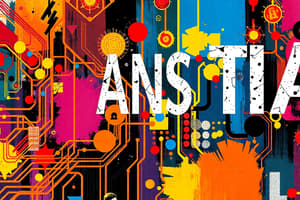Podcast
Questions and Answers
What does the acronym SYN stand for in the context of TCP communication?
What does the acronym SYN stand for in the context of TCP communication?
- Synchronized Transmission
- System Network
- Synchronize (correct)
- Secure Yields
Which mechanism requires the sender to receive an acknowledgment after transmitting data?
Which mechanism requires the sender to receive an acknowledgment after transmitting data?
- Delayed Acknowledgment
- Window Sliding Mechanism (correct)
- Fast Retransmit
- Round-Trip Time Measurement
What is the purpose of the TCP Shutdown (Four-Way Handshake)?
What is the purpose of the TCP Shutdown (Four-Way Handshake)?
- To control transmission rate
- To establish a connection
- To resend lost packets
- To disconnect the TCP connection (correct)
Which of the following statements is NOT true about TCP connections?
Which of the following statements is NOT true about TCP connections?
Which of the following terms describes the process of confirming receipt of data in TCP?
Which of the following terms describes the process of confirming receipt of data in TCP?
Which component of the SNMP model is responsible for translating management information into a compatible form?
Which component of the SNMP model is responsible for translating management information into a compatible form?
What is the main purpose of the Telnet protocol?
What is the main purpose of the Telnet protocol?
What uniquely identifies a session established by Telnet?
What uniquely identifies a session established by Telnet?
Which of the following protocols is primarily responsible for secure message-oriented communications over HTTP?
Which of the following protocols is primarily responsible for secure message-oriented communications over HTTP?
What role does the Network Management System (NMS) play in the SNMP model?
What role does the Network Management System (NMS) play in the SNMP model?
Which protocol operates at the application level, supporting the exchange of information on the World Wide Web?
Which protocol operates at the application level, supporting the exchange of information on the World Wide Web?
What type of connection is facilitated by the TCP protocol?
What type of connection is facilitated by the TCP protocol?
Which protocol allows users to log in to other UNIX machines on a network as if physically present at the host computer?
Which protocol allows users to log in to other UNIX machines on a network as if physically present at the host computer?
What is the primary responsibility of the Internet Architecture Board (IAB)?
What is the primary responsibility of the Internet Architecture Board (IAB)?
Which organization oversees the unique parameters on the Internet, such as IP addresses?
Which organization oversees the unique parameters on the Internet, such as IP addresses?
Which application layer protocol is used primarily for sending emails?
Which application layer protocol is used primarily for sending emails?
What purpose does the Domain Name System (DNS) serve?
What purpose does the Domain Name System (DNS) serve?
What protocol allows a workstation to retrieve mail from the server?
What protocol allows a workstation to retrieve mail from the server?
Which protocol enables the sharing of data and programs between hosts over a TCP/IP network?
Which protocol enables the sharing of data and programs between hosts over a TCP/IP network?
Which of the following protocols is a simple alternative to FTP that uses UDP?
Which of the following protocols is a simple alternative to FTP that uses UDP?
What is the main function of the Application Layer in networking?
What is the main function of the Application Layer in networking?
What is the primary focus of the IEEE organization?
What is the primary focus of the IEEE organization?
Which of the following LAN technologies is not associated with IEEE's Project 802?
Which of the following LAN technologies is not associated with IEEE's Project 802?
What does the Telecommunications Industry Association primarily focus on?
What does the Telecommunications Industry Association primarily focus on?
Which of the following standards is published by the American National Standards Institute?
Which of the following standards is published by the American National Standards Institute?
Which organization is responsible for oversight of Internet standardization processes?
Which organization is responsible for oversight of Internet standardization processes?
The TIA/EIA 568 – B Series provides guidelines specifically for what?
The TIA/EIA 568 – B Series provides guidelines specifically for what?
What role does the Internet Engineering Steering Group (IESG) play?
What role does the Internet Engineering Steering Group (IESG) play?
Which statement correctly describes the Electronic Industries Alliance (EIA)?
Which statement correctly describes the Electronic Industries Alliance (EIA)?
What is the primary purpose of the Transport Control Protocol (TCP)?
What is the primary purpose of the Transport Control Protocol (TCP)?
Which of the following best describes User Datagram Protocol (UDP)?
Which of the following best describes User Datagram Protocol (UDP)?
What type of service do ports numbered from 0 to 1023 provide?
What type of service do ports numbered from 0 to 1023 provide?
How are port numbers represented in the transport layer protocols?
How are port numbers represented in the transport layer protocols?
What mechanism does TCP employ to ensure reliable communication?
What mechanism does TCP employ to ensure reliable communication?
Which statement is true regarding TCP and UDP?
Which statement is true regarding TCP and UDP?
What is the maximum number of distinct port numbers available in transport layer protocols?
What is the maximum number of distinct port numbers available in transport layer protocols?
Which protocol would be best suited for applications that do not require guaranteed delivery of packets?
Which protocol would be best suited for applications that do not require guaranteed delivery of packets?
Flashcards are hidden until you start studying
Study Notes
Standardization Organizations
- IEEE (Institute of Electrical and Electronics Engineers): Focuses on standardizing LAN technologies, contributing to Ethernet (802.3), token-ring (802.5), and Wireless LANs (802.11).
- ANSI (American National Standards Institute): Composed of industry and government representatives, defining standards for various fields, notably ASCII (American Standard for Code Information Interchange) and SCSI (Small Computer System Interface).
- EIA (Electronic Industries Alliance): A trade organization within the US, focusing on standards that promote the growth of computer and electronic industries.
- TIA (Telecommunications Industry Association): Establishes standards for IT, wireless, satellite, fiber optics, and telephone equipment. Well-known for the "TIA/EIA 568 – B Series" guidelines for network cable installation in commercial buildings.
- IETF (Internet Engineering Task Force): Shapes the development of the Internet and standardizes internetworking technologies.
- ISOC (Internet Society): Oversees the overall development of the Internet.
- IESG (Internet Engineering Steering Group): Manages the introduction and update process for Internet standards, under the guidance of ISOC.
- IAB (Internet Architecture Board): Serves as a technology advisor to ISOC, responsible for developing protocols and architecture for the Internet.
- IANA (Internet Assigned Numbers Authority): Manages Internet naming and addressing, including IP addresses.
- ISO (International Organization for Standardization): Develops a wide range of standards, many relevant to networking.
Application Layer Protocols
- SMTP (Simple Mail Transfer Protocol): Uses TCP/IP for the reliable and efficient transfer of emails over the internet.
- POP3 (Post Office Protocol, version 3): A TCP/IP protocol allowing workstations to retrieve mail stored by the server.
- TFTP (Trivial File Transfer Protocol): A simple alternative to FTP, utilizing UDP to transfer files between systems.
- FTP (File Transfer Protocol): Uses TCP to enable the sharing of programs and data between hosts across a TCP/IP network. It establishes a virtual connection for control information and a separate one for data transfer.
- NFS (Network File System): A TCP/IP protocol facilitating the mounting of drives on remote hosts, making them accessible as if they were local.
- DNS (Domain Name System): Converts domain names and publicly advertised network nodes into IP addresses for internet use.
- SNMP (Simple Network Management Protocol): Manages and monitors the exchange of management information between networks and components. Enables network administrators to handle configurations, gather statistics, track network performance, and manage security.
- Telnet (Terminal Emulation Protocol Network): A TCP/IP protocol utilizing TCP to establish a connection between server and client. Uses a daemon (remote host) and virtual terminal (VTY) connections.
- rlogin (Remote login application): A UNIX command allowing authorized users to log in to other UNIX machines on a network, interacting as if physically present. Enables various actions based on host permissions.
- HTTP (Hypertext Transfer Protocol): Supports the exchange of information on the World Wide Web and internal networks. Developed by the IETF.
- HTTPS (Hypertext Transfer Protocol over Secure Socket Layer): A secure message-oriented protocol designed for HTTP use.
- SSL (Secure Sockets Layer): A security protocol working at the socket level, placed between TCP and the application layer to encrypt/decode data and authenticate entities.
### TCP and UDP Connections
- TCP (Transmission Control Protocol): A connection-oriented TCP/IP transport layer protocol. Provides reliable data delivery, duplicate data suppression, congestion control, and flow control, essential for many application protocols.
- UDP (User Datagram Protocol): A connectionless TCP/IP transport layer protocol. Offers unreliable, best-effort service. Sends independent packets of data called datagrams without delivery guarantees.
### Port Numbers
- Port Number Range: 0 to 65,535, representing 16-bit numbers.
- Well-known Ports: Numbers 0 to 1023 are reserved for services like HTTP, FTP, and other critical system services.
### TCP Connection Establishment (Three-Way Handshake)
- SYN (Synchronize): The initiator sends a SYN packet to the receiver, requesting a connection.
- SYN-ACK (Synchronize-Acknowledge): The receiver responds with a SYN-ACK packet, acknowledging the request and signaling its readiness for connection.
- ACK (Acknowledge): The initiator sends an ACK packet, confirming the receiver's response and establishing the connection.
### TCP Communication
- Sequence Numbers and Acknowledgment Numbers: Used to ensure reliable and ordered data transmission.
- Window Sliding Mechanism: Controls data transmission speed by requiring acknowledgments from the receiver after transmitting a certain number of data packets.
### TCP Connection Termination (Four-Way Handshake)
- Used to disconnect the TCP connection and release system resources after data transmission is complete.
Studying That Suits You
Use AI to generate personalized quizzes and flashcards to suit your learning preferences.




